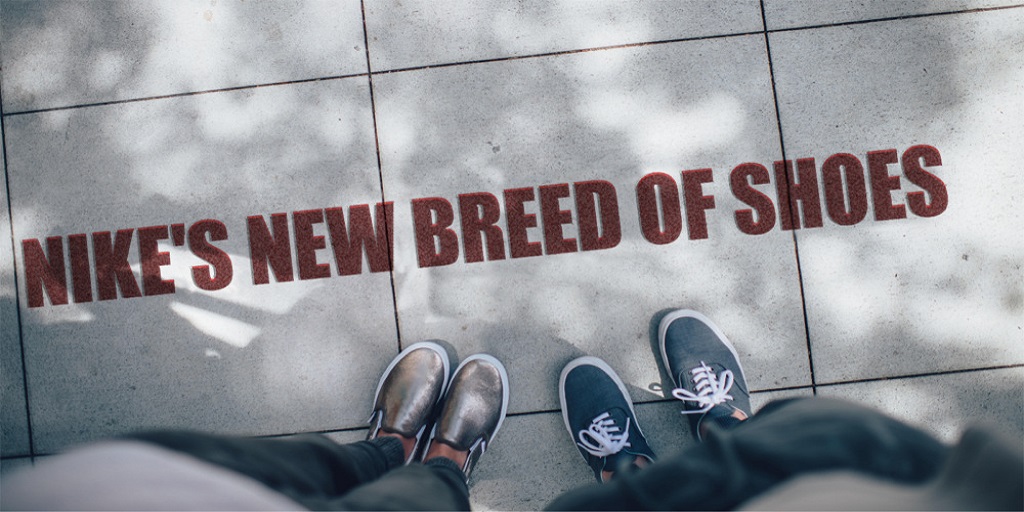Nike’s New Breed of Shoes
Self lacing shoes.
We’ve all seen them in movies. We’ve seen them in games. And we may have seen them in our dreams and fantasies. But now those dreams and fantasies may become reality. Nike has just unveiled shoes that are capable of tying them selves. Although Nike has actually produced self lacing sneakers before, Nike may be working on new shoes that will break current boundaries of awesomeness for shoes. Before we explore the new type of sneaker, let’s take a look at one the previous models that Nike had for its self lacing shoes.
The shoes you’ve waited awhile for after seeing the movie, Back to the Future.
We’ve seen self tying shoes from the movie “Back to the Future,” where Marty Mcfly donned the famous self tying shoes. Most of us probably wished for a pair thought it’d be awesome to own self tying shoes. Nike heard our wishes and began selling the famous self tying shoes owned by Marty McFly. Nike also patented the famous self tying shoes. U.S. Patent No. 8,769,844 covers the self tying shoes. The patent describes the shoes as “[a]n article of footwear with an automatic lacing system… The automatic lacing system provides a set of straps that can be automatically opened and closed to switch between a loosened and tightened position of the upper. The article further includes an automatic ankle cinching the system that is configured to automatically adjust an ankle portion of the upper”
Click here to read the entire 8,769,844 patent.
The shoes that are breaking boundaries
Nike announced that they will be introducing shoes that can do a little bit more than just tie themselves. The Nike Adapt app along with the new Nike Adapt BB shoes will now allow a shoe to adjust the tightness of automatic laces. The snugness of the shoe will adjust based on the lacing. Moreover, the wear can also change the tightness of the lacing manually or input commands beforehand.
Click here to read more about the new shoes.
Click here to watch a video on the new shoes.
One of Nike’s latest patents has introduced an invention similar to the Nike Adapt BB
Nike recently just received U.S. Patent No. 10,178,890. This patent discloses something that sounds quite similar to the Nike Adapt BB. In the patent, there is mention of a device that “may include a shoelace that is attached to the upper, and a lace motor that is mounted inside the sole structure and operable to selectively transition the shoelace/strap between tensioned and untensioned states. The footwear controller may communicate with the lace motor to determine a current state of the shoelace. In this instance, a command signal may be transmitted to the IES alert system only when the shoelace is in the tensioned state. For at least some configurations, the tensioned state may include multiple discrete tensioned positions; the IES system may include a lace sensor that detects a current discrete tensioned position for a current user. The footwear controller may communicate with the lace sensor to determine if the current discrete tensioned position corresponds to a memory-stored validated lace tensioned position (i.e., authenticated to a registered user).”
Click here to read the entire patent.
Why would Nike need patents to protect these shoes?
No doubt these shoes are cool. And no doubt Nike probably spent thousands, if not millions, on creating these shoes and perfecting them. Since so much money and time went into creating these shoes, Nike has to ensure that the shoes are properly protected. The patents covering these shoes help ensure that Nike’s competitors can’t produce the same shoes. Just think how much more difficult it would be for Nike to sell their products if Reebok or Adidas could make the same self tying shoes.
Lower prices would be great in the short term. But it may not be as beneficial in the long term.
You may be thinking that it would be better off for consumers if they had more choices for self tying shoes to pick from. Prices would be lower and there would be more variety. But what would happen in the long run? Moreover, would Nike be as willing to disclose their new idea if they spent countless hours and millions of dollars investing in a product just for their competitors to copy their products off the bat? The answer is probably not. Thus, patents incentivize inventors (or companies that hire inventors) to disclose their invention in exchange for protection for that invention.
Infringement is only a step away
These self lacing shoes are an amazing idea. Other shoe company may infringe on Nike’s patent if they reproduce the main components of the self lacing mechanism. Direct patent infringement requires the alleged invention or product to contain every single element contained in the patent. Infringement can also occur under the doctrine of equivalence. This would mean that even though every element is still technically there, whether it is the same element or an equivalent.
What are your thought on Nike’s new shoes? Leave a comment below to let us know what you think!
Interested in more intellectual property? Here’s a video!
Sign up today!
Does this article interest you? Subscribe to the LoTempio Law email newsletter to receive posts and updates just like this conveniently in your email box!
If you’ve enjoyed this blog post, we have lots more where this came from, including an Inventors Guide Video Series where we help you turn your good idea into a profitable invention, and tons of other great content. Simply enter your email address and hit sign up and you’ll get everything, including blog posts like these, conveniently in your email box!
Have any questions? Give us a call at 1-800-866-0039. Consultations are FREE.
Disclaimer: This article is not legal advice. It is only for educational or entertainment purposes only. Please do not use the article or contents of the article without permission. For legal advice and questions, please contact registered Patent Attorney Vincent LoTempio.




